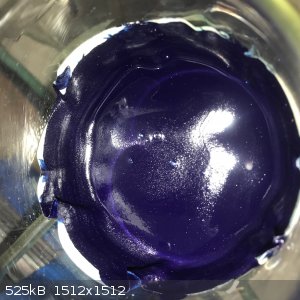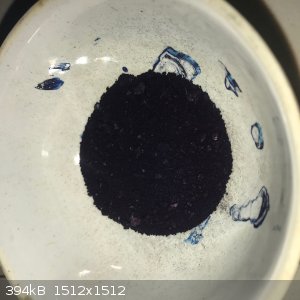Lion850
National Hazard
   
Posts: 514
Registered: 7-10-2019
Location: Australia
Member Is Offline
Mood: Great
|
|
Report on making Prussian Blue
I had a go at making Prussian Blue. I found various threads here on Sciencemadness with ‘Prussian Blue’ in the subject however none detailed a
synthesis (probably because it is a relatively simple experiment).
I had potassium ferricyanide available, but not potassium ferrocyanide. After reading online I decided on the following equation to try and get the
dark-colored insoluble version of Prussian Blue:
FeCl3.6H2O + 3FeSO4.H2O + 3K3[Fe(CN)6] = Fe4[Fe(CN)6]3 + 3K2SO4 + 3KCl + 9H2O
- 9.4g FeSO4.H2O (I have the white monohydrate, not the green) was dissolved in 120ml water with some difficulty; it gave a milky solution which
surprised me; however nothing ppt out when the stirring was stopped.
- 5g FeCl3.6H2O was dissolved in 10g water and this was then poured into the beaker with the ferrous sulphate solution. This mix gave a light brown
solution.
- 18g 3K3[Fe(CN)6] was dissolved in 50g water.
- Slowly add the potassium ferricyanide solution to the beaker with the FeSO4 and FeCl3 solution under magnetic stirring. It immediately gave a very
dark blue-purple suspension. It also became an emulsion and hard to stir; I transferred it into a bigger beaker with bigger stir bar and topped up
with water to around 300ml. Then stirred for some 30 minutes.
- Started vacuum filtration. What a struggle! Even under very high vacuum the filtration rate was very slow, drop for drop. I filtered it in 2
batches, cleaning the filter in between. The remainder was a lovely dark blue-purple, see photo below. The filtrate was green, I don’t know whether
this green color was from excess FeSO4 or another salt that formed.

- First batch yielded 49g of wet material. This was placed in the hot sun for 6 hours, and the weight reduced to 20g and appeared reasonably dry. It
was then crushed into a powder and dried further on a steam bath for 2 hours. Drying it darkened the color. Final weight was 12.5g.
- The second batch yielded 26.6g wet, this was dried on the steam bath for 3 hours with final weight being 7.4g.
- Total recovery 19.9g of dry free-flowing dark blue-purple powder, some 3g more than theoretical as far as I could work out so it may still be a bit
wet, in spite of appearing bone dry. Or some contamination from the other products; but being that the experiment was done in near 300ml water I would
think most of the soluble products would have ended up in the filtrate. I did attempt to wash the remainder in the funnel, which added to the
filtration pain.
- Photo of the second batch after drying below; but the phone camera struggles to pick up the ‘blueness’ of the bulk powder – looks a bit darker
on the photo than with the eye.

Cleaning up the mess: This product easily stains things, especially if surfaces are not completely dry. I also had the same problem described by
Texium in this post:
http://www.sciencemadness.org/talk/viewthread.php?tid=8093#p...
The product slipped past the filter paper in my vacuum funnel and the frit was stained blue. I followed the same advice given in the post: soak with
dilute NaOH to destroy the Prussian Blue, and then run through dilute HCl to dissolved the ferric oxide that is left after the NaOH treatment. The
mortar and pestle were also cleaned the same way.
I was mindful of cyanide gas generation at all times, there were some unfamiliar smells a few times but they never lasted more than a few seconds. But
I still left the shack for 10 minutes or so each time I smelt something….
If anyone plans to do a similar synthesis just to have a sample make less because filtering is a pain. On the plus side, it dries relatively easily on
a steam bath, and when on the steam bath drying there is no odor coming off other than steam. Seems stable at 100C.
|
|
|
Bedlasky
International Hazard
    
Posts: 1219
Registered: 15-4-2019
Location: Period 5, group 6
Member Is Offline
Mood: Volatile
|
|
Your yield is bigger than 100% because your prussian blue is probably some hydrate. If you something dry on steam bath it doesn't mean that all water
comes off. It is harder to remove chemically bonded water than physically bonded or water which remains in filter with precipitate.
Prussian blue have nice colour. I remember when I made it my first year on high school. We have even "special" funnel for filtration of this compound
(funnel was completly blue  ). ).
|
|
|
teodor
National Hazard
   
Posts: 872
Registered: 28-6-2019
Location: Heerenveen
Member Is Offline
|
|
Did you get Prussian blue or Turnbull's blue? I am asking because you used potassium ferricyanide .
Turnbull's blue: is decomposed by treatment of caustic alkali, is not very soluble in acid solutions.
Prussian blue: soluble in oxalic acid forming deep blue solution (was used as a blue ink), soluble in conc. HCl and precip. again on dilution.
|
|
|
unionised
International Hazard
    
Posts: 5102
Registered: 1-11-2003
Location: UK
Member Is Offline
Mood: No Mood
|
|
https://en.wikipedia.org/wiki/Prussian_blue#Turnbull's_blue
|
|
|
teodor
National Hazard
   
Posts: 872
Registered: 28-6-2019
Location: Heerenveen
Member Is Offline
|
|
Some people also say there is no such thing as nascent hydrogen  I have to check
this difference by myself, old books point difference in properties between Turnbull and Prussian blue. Many metal oxides, for example, also have the
same chemical structure but different properties when prepared by different methods, so I think it could be something like that. I have to check
this difference by myself, old books point difference in properties between Turnbull and Prussian blue. Many metal oxides, for example, also have the
same chemical structure but different properties when prepared by different methods, so I think it could be something like that.
Edit. Treadwell, 1931.
Turnbull's blue : Fe3[Fe(CN)6]2 + KFe+++[Fe(CN)6]-- (so, this name is for the mix of Fe++, Fe+++ and K+ cations)
Prussian blue: Fe4[Fe(CN)6]3 (Fe+++ only).
Can we say that the first one is a solid solution or mix of 2 salts?
Edit 2: The work https://doi.org/10.1021%2Fic50091a012 mentioned in wikipedia nevertheless contains the formula KFe(III)[FeII(CN)6] even for Prussian blue, and not
that one mentioned in the first post of this thread (Fe4[Fe(CN)6]3).
[Edited on 4-11-2020 by teodor]
[Edited on 4-11-2020 by teodor]
|
|
|
Bedlasky
International Hazard
    
Posts: 1219
Registered: 15-4-2019
Location: Period 5, group 6
Member Is Offline
Mood: Volatile
|
|
Teodor: I don't think that prussian blue is trully soluble. Read that article on wiki. Prussian blue can form colloids - maybe it seems like a
soluble, but it's actually a colloid.
|
|
|
unionised
International Hazard
    
Posts: 5102
Registered: 1-11-2003
Location: UK
Member Is Offline
Mood: No Mood
|
|
When i was a chemistry student there was a joke that the only actual application of Mossbauer spectroscopy was to show that Turnbull's blue and
Prussian blue were the same thing.
https://ui.adsabs.harvard.edu/abs/1968JChPh..48.3597I/abstra...
(Good jokes were in short supply)
[Edited on 4-11-20 by unionised]
|
|
|
teodor
National Hazard
   
Posts: 872
Registered: 28-6-2019
Location: Heerenveen
Member Is Offline
|
|
Quote: Originally posted by Bedlasky  | | Teodor: I don't think that prussian blue is trully soluble. Read that article on wiki. Prussian blue can form colloids - maybe it seems like a
soluble, but it's actually a colloid. |
Yes, but look, those articles which says Turnbull's is the same as Prussian compare them in water solutions ... so .... I still don't believe  And Pluto is a planet! And Pluto is a planet! 
|
|
|
teodor
National Hazard
   
Posts: 872
Registered: 28-6-2019
Location: Heerenveen
Member Is Offline
|
|
Thank you for this reference. It says that:
"Insoluble Prussian blue (Turnbull's blue) made by
mixing the solutions of ferric (ferrous) compound and
ferrocyanide (ferricyanide) showed very broad x-ray
diffraction patterns. This was one of the reasons why
the reaction between the two solutions was considered
to be too fast. In order to mix them slowly we used the
following procedure. "
So, am I properly understand that they were failed to get any constant pattern from the traditionally prepared, real compound and studied some
compounds prepared by their own method in assumption that the difference is limited to Fe(II) in cation and Fe(III) in anion and vice versa?
|
|
|
Lion850
National Hazard
   
Posts: 514
Registered: 7-10-2019
Location: Australia
Member Is Offline
Mood: Great
|
|
Gents great to see all the comments. Indeed I do not know whether I made Prussian or Turnbull's blue; I also saw the mentioned references saying they
are basically the same compound. Anyway, its a nice dark blue color 
I like the look of Cadmium Red; anyone happen to have a synthesis for this?
|
|
|
B(a)P
International Hazard
    
Posts: 1114
Registered: 29-9-2019
Member Is Offline
Mood: Festive
|
|
Quote: Originally posted by Lion850  | Gents great to see all the comments. Indeed I do not know whether I made Prussian or Turnbull's blue; I also saw the mentioned references saying they
are basically the same compound. Anyway, its a nice dark blue color 
I like the look of Cadmium Red; anyone happen to have a synthesis for this? |
Cadmium is one of my favourite elements and cadmium red is definitely on my list of things to do. I had started doing some research on it and found
this patent to be somewhat useful. I haven't found time to go though it in detail though. https://patents.google.com/patent/US2643196A/en
|
|
|
HydrogenSulphate
Harmless

Posts: 38
Registered: 13-10-2019
Member Is Offline
Mood: Caffeinated
|
|
That's a beautiful dark blue colour. Are you hoping to dye some jeans with it? 
|
|
|
woelen
Super Administrator
        
Posts: 7977
Registered: 20-8-2005
Location: Netherlands
Member Is Offline
Mood: interested
|
|
I think that the extra weight is due to the presence of K(+) ions in the mix. So you get something like KFeFe(CN)6 and that adds up additional weight
of K(+) and a corresponding CN(-).
|
|
|